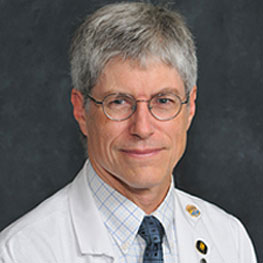USF study: Most patients stop drugs for essential tremor after deep brain stimulation surgery
Medications lose effectiveness for many with longstanding tremors
Tampa, FL — Deep brain stimulation, a surgical procedure to suppress faulty nerve signals, allowed 77 percent of patients to stop the medications used to treat their essential tremors within one year following the surgery, University of South Florida researchers report.
“It’s a significant finding demonstrating that patients see a lot of symptom improvement with this treatment option,” said Andrew Resnick, a research assistant in the USF Health Department of Neurology. Resnick will present results of the limited retrospective study April 12, 2011, at the annual meeting of the American Academy of Neurology in Honolulu, Hawaii.

USF Health neurologist Dr. Theresa Zesiewicz with research assistant Andrew Resnick
Essential tremor, which affects the hands, head and voice, is three times more prevalent than Parkinson’s disease. The largely hereditary neurological condition can cause uncontrollable shaking that interferes with normal daily activities such as eating, drinking and getting dressed. Tremors can begin in early adulthood and become more severe as a person grows older.
While medications (primidone, propranolol and/or topiramate) help alleviate essential tremors in some patients, over time many patients discontinue the drugs because their effectiveness wanes or the side effects become intolerable, said USF Health neurologist Theresa Zesiewicz, MD, who was the lead author in developing the AAN’s first guidelines for treatment of essential tremor. “Essentially, they just give up trying to treat essential tremor.”
The USF study reviewed the charts of 31 patients who underwent unilateral deep brain stimulation (DBS) surgery for essential tremor from 2000 to 2010. The therapy uses an implanted device similar to a pacemaker to stimulate a targeted region of the brain with electrical impulses, blocking or correcting abnormal nerve signals that cause the tremors.
At the time of surgery, 20 of the 31 patients had been diagnosed with essential tremor for 10 or more years and 11 had been diagnosed for less than 10 years.

Resnick will present the findings April 12 at the American Academy of Neurology’s 2011 Annual Meeting and again at the Movement Disorders Society’s 15th International Congress of Parkinson’s Disease and Movement Disorders in June.
The researchers found that all 13 patients still taking anti-tremor medications at the time of DBS surgery gained effective control of their tremors following the procedure. In fact, symptom improvement was so good that 10 patients in this group (77 percent) stopped the anti-tremor medications within one year of surgery. The remaining three (23 percent) continued to take propranolol, an antihypertensive as well as an anti-tremor drug, only because they still needed it to control blood pressure.
Eighteen of the 31 patients (54 percent) had discontinued anti-tremor medications a year or more before the DBS surgery – 10 because the medications stopped working and eight because of adverse side effects such as nausea, headaches and other flu-like symptoms, drops in blood pressure, cognitive impairment or depression. Most patients in this group had long-standing essential tremor (10 or more years). All these patients also benefitted from the DBS surgery, though some experienced longer symptom improvement than others.
USF Health neurosurgeon Dr. Donald Smith implanted the first DBS device for essential tremor during a North American clinical trial in 1993 and has performed over 200 procedures since the FDA approved the anti-tremor surgery in 1997.

USF Health neurosurgeon Dr. Donald Smith is a pioneer in deep brain stimulation surgery for essential tremor.
By the time patients reach the point of contemplating surgery, the tremors are usually very debilitating, said Dr. Smith, surgical co-director of the Movement Disorders Clinic in the USF Department of Neurosurgery.
“People may not be able to write, or comb their hair; they can’t use tools, can’t sew or knit. They have difficult feeding themselves and drinking, so they’re often embarrassed to go out to eat.” Dr Smith said. “It a rewarding procedure to perform, because most patients come in with high levels of disability and can be turned around quickly. It’s a home-run surgery.”
A limitation of the USF study was that only unilateral DBS, which treats one side of the brain affecting tremors in the dominant hand, was examined. Bilateral DBS for tremor in both hands is associated with more side effects, Dr. Zesiewicz said, but patients are often satisfied when they regain control in the dominant hand.
Future research should include larger, long-term studies investigating how long the tremor control effects of DBS last, the researchers conclude. For instance, will patients who have undergone the procedure need medication again 10 to 20 years after the surgery, or can physicians alter the intensity of electrical impulses delivered by the DBS device so that the procedure’s benefits are sustained?
In addition to Resnick, Dr. Smith and Dr. Zesiewicz, USF Health’s Teresita Malapira, Dr. Fernando Vale, Kelly Sullivan (neuroepidemiologist) and Amber Miller, and the University of Florida’s Dr. Michael Okun conducted the study.
– USF Health –
USF Health is dedicated to creating a model of health care based on understanding the full spectrum of health. It includes the University of South Florida’s colleges of Medicine, Nursing, Public Health and Pharmacy, the School of Biomedical Sciences and the School of Physical Therapy and Rehabilitation Sciences; and the USF Physician’s Group. With more than $394.1 million in research grants and contracts in FY2009/2010, the University of South Florida is a high impact global research university.
Media contact:
Anne DeLotto Baier, USF Health Public Affairs
(813) 974-3300 or abaier@health.usf.edu

